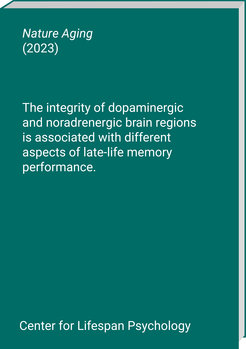Dopaminergic versus noradrenergic brain regions are linked to different aspects of memory performance in old age

Dahl, M. J., Bachman, S. L., Dutt, S., Düzel, S., Bodammer, N. C., Lindenberger, U., Kühn, S., Werkle-Bergner, M., & Mather, M. (2023). The integrity of dopaminergic and noradrenergic brain regions is associated with different aspects of late-life memory performance. Nature Aging, 3(9), 1128–1143. https://doi.org/10.1038/s43587-023-00469-z
Various brain-related pathologies are associated with late-life dementia. Understanding the etiology of these pathologies may pave the way for mitigation and prevention. One of these pathologies is Alzheimer’s disease. The accumulation of abnormal tau proteins is among the first signs of potentially developing Alzheimer’s disease late in life. In most people's brains, such signs can already be detected at around 30 years of age. Abnormal tau initially forms in small subcortical nuclei that produce neurotransmitters, most notably dopamine and noradrenaline.
By using magnetic resonance imaging (MRI) in older adults, we found that alterations in brain regions producing noradrenaline were linked to deficits in episodic memory, that is, the ability to learn and remember events in the long term. At the same time, alterations in brain regions primarily associated with dopamine were linked to working memory, or the ability to keep information in mind over shorter periods of time. Unravelling the distinct contributions of different neurotransmitters to age-related memory losses helps to improve the understanding of cognitive aging with and without dementia.
